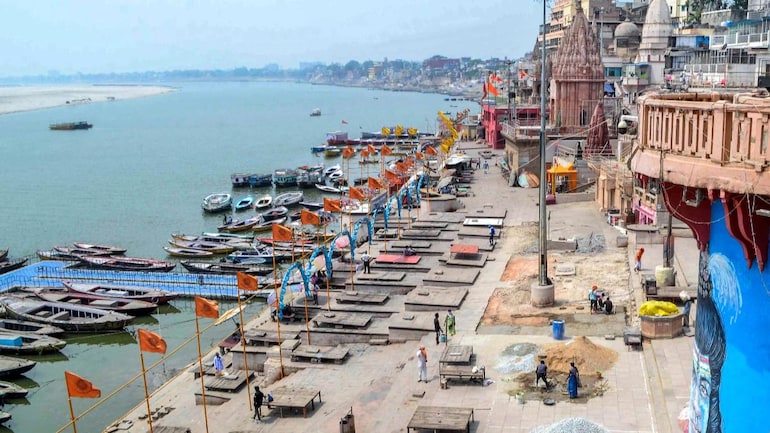After the devastation of the city of Varanasi, Covid-19 has reached the rural parts of Uttar Pradesh. However, the villagers do not have access to vaccinations as they do not have the internet and smartphones to register for them. (Photo credit: PTI file picture from Varanasi Ghats)
India’s vaccination policy dictates this Everyone in the age group from 18 to 44 years applies in advance via the CoWIN website, the Aarogya Setu app or the Umang app to get vaccinated against Covid-19. Walk-in vaccinations are not permitted for this age group.
While it can be done in the urban areas, where internet access is generally guaranteed and most people have access to smartphones, the story is very different in the Indian villages. Access to Covid vaccinations has been restricted by the country’s digital divide, even though the virus has reached and started devastate the rural areas of the country.
India Today TV’s team visited the rural areas of Varanasi and found that most people do not have the internet access, smartphones, electricity and awareness required to register for the vaccine.
No internet and smartphones
A resident of Kashigaon Village said, “We have a lot of problems because we don’t have information on how to register for the vaccine with our phones. Nobody in the village knows how to do it, and no government team has come to educate us. I’ve tried to help many people in my village since I had a smartphone, but most of the people don’t. “
These villages, which have recently been electrified, do not have proper access to the internet and only inconsistent phone signal. Forget the smartphone, most of the residents here have simple cell phones.
While several villagers said they had no real internet or electricity, the local legislature from Ghatampur constituency seems to think otherwise.
#Coronavirus devastates rural India. There is no internet, no smartphones in villages. How do I register for vaccination? Check out this basic report from @ PreetiChoudhry of a #Varanasi Village.#CovidDespatch pic.twitter.com/FMWkEhX1Lc
– IndiaToday (@IndiaToday) May 14, 2021
“Every house in this constituency has at least one cell phone, if not two or three. Sometimes the signal is bad, but this can also happen in cities. The important thing is that we all work together to defeat Covid, ”said the MLA.
The subdivision’s magistrate, Arun Srivastav, confirmed the confidence of the MLA. He explained that those who are struggling can visit a common service center (CSC) for internet access and assistance with vaccine registration.
“There are eight such centers in our constituency. Or people can get help from teenagers who may have smartphones, ”explained Srivastav.
A local journalist from Bhadras Village, Uttar Pradesh said, “When you call villagers to Common Service Centers for help with registration, why not just vaccinate every now and then? That would be better. If walk-in vaccination camps are organized in the villages with the Aadhar card as the only requirement, vaccination will be quick in the rural areas. “
Bhadras village had run out of electricity for the past four days. But the village of Pradhan is still confident that the vaccination campaign will be successful here.
Vaccine hesitation
The journalist also stated that many people in Bhadras village are afraid to get vaccinated after some villagers aged 45 and over have died of Covid-19 in the past 15 days despite taking the first shot.
“There’s a rumor here that the vaccine does more harm than good. That mindset needs to be eliminated, ”he said.
The same story of lack of access and hesitant vaccine can be seen in all villages in Uttar Pradesh. Covid vaccination seems like a privilege when it should be a right.
Crumbling medical infrastructure in villages
In the meantime, the virus continues to spread in the villages of the state and the United States rural medical health infrastructure just cannot cope.
In Kashigaon, seven people died of Covid in eight days, but no administration representative came to check it out. While medical resources like oxygen and ventilators are simply not available, private healthcare institutions charge enormous sums of money.
ALSO READ: India Today Impact: Bathroom Open, Doctors Back, Garbage Removed from UP Hospital’s Covid Section
Local resident Rajesh Moria shared his experience: “My mother was not doing well. We ran around to get a hospital bed. When we finally got one in a private facility, they did not give it any oxygen, even though the doctor had announced it would. They didn’t even check their oxygen levels. They asked us to get 4,000 rupees worth of medicines that we could not find. She died a while later. The hospital refused to give us the body until we paid the bills, which were 45,000 rupees. “
Moria’s mother was admitted to a health facility a month ago to deal with the surge in Covid-19 cases. Sunrise Hospital, 25 km from Varanasi, promises good health care to patients, but the reality is far from it. There are no ventilators or well-equipped intensive care units. Instead, there are only big bills.
The story of the holy city
The city of Varanasi, which is generally a lot of people, is quiet now amid the Covid crisis. The only place that is busy is Harishchandra Ghat, which is dedicated to the cremation of Covid patients. Locals say the ghat hasn’t stopped burning in 20 days. Those who cannot afford wood are waiting for the better End the cremation of loved ones so the wood can be reused.
#Varanasi: The eternal city under pandemic. #CovidDespatch With @ PreetiChoudhry. #ITLivestream #Coronavirus https://t.co/ONeVDkqMW8
– IndiaToday (@IndiaToday) May 14, 2021
A local boatswain told India Today TV that Varanasi has been badly hit by Covid-19 because Lord Shiva is angry.
ALSO READ: Overworked, Underpaid: Asha Workers, the Front Warriors in the Battle of UP in Covid Basic Report


إرسال تعليق